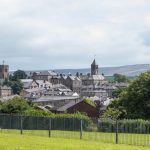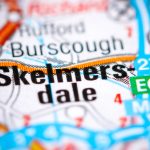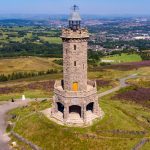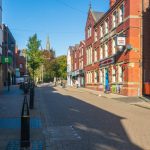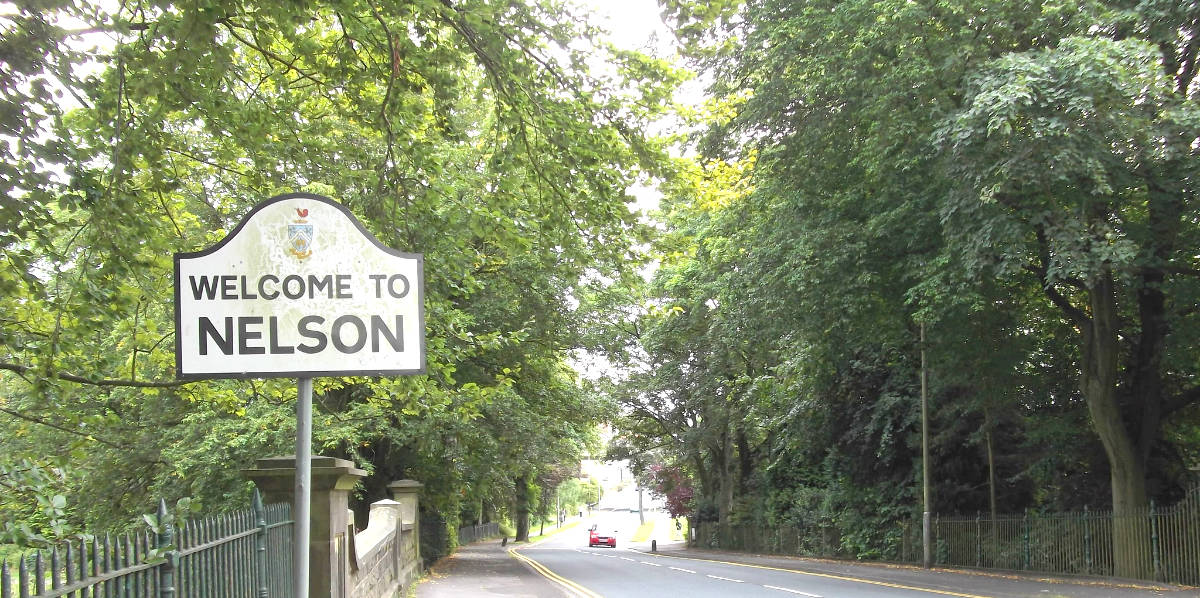
Nelson is one of the Lancashire towns that surrounds the famous Pendle Hill. This region of England has a long industrial heritage, having grown exponentially due to coal mining, stone quarrying, cotton spinning, and other such 18/19th-century work. Nelson takes a slightly different approach to its industrial heritage. This town is famous for jelly babies and Victory V sweets rather than coal mining.
Let’s roll up our sleeves and get on with the standard deep delve into the history, attractions, and best bits of Nelson in Lancashire. Ready for another Five Minutes Spare travel guide adventure? We sure are. Come hop on and enjoy the ride.
The Early Days of Nelson
Prior to 1851, the town council records that Nelson was little more than a ‘peat-covered and rain-sodden wilderness’. While there may not have been a settlement back in ancient times, we were certain we could dig up a little more than that. We put on our investigative hats and got the spades out.
The next source we found gave us a slightly earlier date. This page names the town’s beginnings in 1816, just after the Leeds-Liverpool canal came into being. At that time, we Brits built canals all over the place. We used shire horses – the ones with the furry feet – to transport goods all over. Most canals didn’t really run as much as they pooled. Interestingly we had to come back here and add a note because the canal opened in 1796. Additionally, the town began with a small mill belonging to the Ecroyd family which existed as early as 1740. They would later begin spinning cotton in their own mill in 1780.
Roman Times
It didn’t take all that much research to find evidence of Roman activity near the town. Admittedly, the Caster Cliff Roman hill fort is closer to Colne than it is to Nelson. However, the fact that the Romans went to the effort of building a hill fort on this site means that it was somehow important. If it was anything like the rest of the north, the Romans had trouble controlling it. The farther they got from London, the harder it was to keep Britons subdued.
Funnily enough, it was the same story when the Normans invaded. In fact, both the Roman map of Wales and Scotland and the Norman accounts through the Domesday Survey are similar. Nobody had a clue what was going on. The natives liked it that way.
Rumour has it that before Nelson there were several small villages. Notably Little Marsden, which was southwest of the river (the Walverden Water). Greater Marsden, its counterpart, included part of Colne, too.
Medieval Times in Nelson
We would normally turn to the Domesday Book to record what a town included back in 1086. Unfortunately, Nelson didn’t exist. If it did, the officials would register it under Cheshire instead of Lancashire because they couldn’t tell the difference. Many of the northern towns were not mentioned. Some because of politics and some because, like Nelson, they didn’t exist. Notably, the Normans didn’t build any castles here to keep control of the populace, so there is that at least.
Even though there is scant evidence that the town even existed in Medieval times, there were rich landowners living in the area. The Ecroyds are only one example. If we look at the local area, we find multiple old historic buildings dotted around Lancashire. These are the remnants of those wealthy landowners’ estates. You have Towneley Hall in Burnley, Samlesbury Hall, and even Hoghton Tower nearby. Let’s take a short break from this distinct lack of history in the hopes that it gets more interesting during the industrial period.
Fun Facts about Nelson Town
At this stage in any tour guide article, we like to stop and highlight some of the fun facts from the area. Here is all the gossip we could scoop up about Nelson town. We warn you; it isn’t as bad as some of the other towns we have reviewed. You can find them on the Five Minutes Spare website. Otherwise, here is what you need to know about Nelson Town in Lancashire:
- People from Nelson should not be confused with the Nelsonians in Wales, America, Africa, or in Australia. It’s a popular name for a town it seems!
- In 1998 the Lancashire Telegraph ran an article about the town, jokingly calling it the town without a past. They were not wrong.
- The pub from whence the town draws its name opened after Nelson’s victory in 1805 courtesy of local resident Matthew Pollard.
- One reporter of old said that the factories and mills in Nelson appeared like mushrooms overnight. He wasn’t wrong, either.
So, Nelson has little history and an affluent industrial past. Let us jump back in on that history and see if it gets any more interesting.
The Industrial Revolution
The Preston Guardian ran an article about Nelson in 1881, claiming that fifty years before it had not existed. The town was a collection of small villages. In 1851 the town’s population was 6,068 people strong. The opening of the Leeds – Liverpool canal around the middle of the century meant that the millers and manufacturers of the area were free to transport goods between towns. Before this, the journey would have to happen over land and via carriage. This shift dramatically improved the amount of goods that could be transported in one go. This growth in demand meant larger shipments which received further progress still by the arrival of the railway in 1849.
Population Growth
By 1872, local reporters described the town as “a village in Little Marsden Township.” They described a chapel which opened in 1865 and a post office which belonged to Burnley. The opening of the railway helped name the town. They couldn’t call two stops so close to each other ‘Marsden’, so they went with the Nelson, instead.
In 1864 a local board was formed in Nelson. They would light and clean the streets. In 1890 the town got its first charter of Incorporation. Thereafter the town became a Victorian New Town. These were not as bustling as the New Towns of the mid-20th century, but they did grow tremendously quickly due to the spurt of industry. In 1871 the town’s population had hit over 10,000 people and the 1891 census showed that 21% of the people who lived in the town were born elsewhere. The population peaked in 1921 at 39,841 which is around the same as it currently is.
Victory V’s
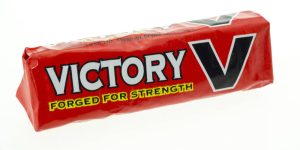
Invented in Nelson in 1864 they originally contained Chloroform!
Image: Lenscap Photography/Shutterstock.com
No look at Nelson’s history would be complete without mentioning probably its most famous invention The “Victory V” Cough Lozenge. These liquorice-flavoured sweets were devised by Thomas Fryer and Edward Smith in 1864. Innitially each sweet was hand-made and meticulously dosed with the correct amount of therapeutic ingredients, mainly liquorice but also chloroform! The factory that made them also started making jelly babies, then under the slightly ghoulish name of unclaimed babies. The factory was demolished in 1988 but you can still buy Victory V Sweets and of course, Jelly Babies are now part of the Bassets Confectionary range.
20th Century Nelson
The mills were cotton based, the textile industry is the driving force there. Locals wove Venetian, Florentine, and Italian fabrics. While the surrounding towns focused on the spinning part, the climate here was better for weaving. By 1921, when the town’s population was at its highest, about 17,000 people in Nelson were weavers.
The town has always had a strong unionist presence. This found proper life in 1911 and 1912 when protests saw union members stage lockouts. The working conditions in the mills were so bad that unionists down south managed to convince Gandhi to visit them when he was on tour in London. Of course, he didn’t make it this far north, but the visit did cause him to boycott cotton made in the UK for months. This did help improve conditions. However, the protests that had led, to that point earned the town of Nelson the nickname of Little Moscow.
As of the start of the First World War, the town had earned a reputation. There was a divisive split down the middle between those that wanted to fight for their country and those that looked at the horrific working conditions and poverty of the town and decided their families needed bread more than death. After the First World War, the town fell into a depression. The Great Depression was happening everywhere, but in places like Nelson who already had nothing, you can imagine how little the people had.
By 1921, when the town’s population was at its highest, about 17,000 people in Nelson were weavers.
Cotton On The Wane
Unemployment hit 30% at one point in the 1920s. By the 1930s the cotton industry was in decline. Locals saved the town from an ultimate death with the arrival of Victory Babies, later to become the jelly babies we know and love today. Nelson confectioner Thomas Fryer worked with a local doctor to create the Victory V lozenge towards the end of WWI. The town also had 20 or more engineering businesses which aided the surrounding towns with architecture and construction.
The town’s landowners opened Walverden Mill in 1951, starting a chain reaction of mill ownership. The mills were cotton based, the textile industry is the driving force there. Locals wove Venetian, Florentine, and Italian fabrics. While the surrounding towns focused on the spinning part, the climate here was better for weaving. By 1921, when the town’s population was at its highest, about 17,000 people in Nelson were weavers.
The town has always had a strong unionist presence. This found proper life in 1911 and 1912 when protests saw union members stage lockouts. The working conditions in the mills were so bad that unionists down south managed to convince Gandhi to visit them when he was on tour in London. Of course, he didn’t make it this far north, but the visit did cause him to boycott cotton made in the UK for months. This did help improve conditions. However, the protests that had led, to that point earned the town of Nelson the nickname of Little Moscow.
Post-WWII
After WWII, the cotton market was absolutely finished. There were 22,000 looms in Nelson but by 1964, there were only 10,000. 46% of the weavers in town were unemployed as technology replaced them. Nevertheless, 1999 records show that a full 12% of the town’s industries still focused on textiles. Other big companies in town are Pendle Travel – which is now part of Thomas Cook. Clothing, shoes, chemicals, furniture making, and construction were all important in town throughout the 20th century.
Despite all of this growth and all of the money in the area, the town council didn’t exist until 2008. Since then, the population has steadied out and unemployment had tailed off. The town is large enough to be a local trading town, but it also houses some serious businesses and a lot of goodwill. Nelson is a delightful place to live with plenty of opportunity, or at least more opportunity than the people who lived here a hundred years ago had.
Famous People from Nelson
In this section, we like to take a brief pause and remember some of the famous people that came from the area. Here is a list of the people in Nelson you might be thrilled to meet in the bread aisle:
- Nelson has its own George Cross recipient, mister George Abbott.
- Several footballers, including Richard Baird, Harry Clayton, Sam Warhurst, Roger Tattersall, and Fred Whittaker
- Children’s author Hazel Townson
- Famous Lancs comedian Tommy Trafford
- Actor Robin Kermode
- English guitarist and singer from the 60s band The Hollies Tony Hicks was a Nelson man. He achieved Rock and Roll hall of fame status in 2010.
There are famous people from all walks of life here in Nelson. You never know who you might cut up in traffic or whose hand you might brush over the melons in Tesco. Take your camera.
Not A lot Of People Know That
The town got its name from a pub. No kidding. The town was originally an amalgamation of a few villages. Two of the villages were Little and Greater Marsden. Unfortunately, there was already a popular Marsden town down in Yorkshire. Since Nelson was a late bloomer, it had to take whatever names were not in use yet. There was a pub in town named the Admiral Lord Nelson Inn, and over time, the Marsden with the Nelson inn simply became Nelson.
Best Attractions in Nelson
It’s time to find out what the best parts of Nelson are. Here are the things that locals recommend you see if you are visiting.
Historic Sites
The only relevant historic site in town is the Nelson Bar. This place still stands as it would have back in the day when it created the town’s name. The Lord Nelson bar sits on Nelson street in Nelson town. All are named after it. The pub is over 200 years old and is going strong. It will still be standing when the next industrial revolution hits. It’s so old that it routinely makes local news.
Landmarks
Although the town might not have enough history to have established its own landmarks, it does have a few tricks up its sleeve. Being in the Pendle borough, the town lies on the Pendle Sculpture Trail. This sculpture trail features statues and sculptures of witches, bats, and even creations that you can’t place. Local groups sometimes run events around them and school groups often study them. It’s a fun day out walking for all the family.
Museums and Galleries
The British in India Museum is in Nelson and it is one of a kind. It sports a collection of artefacts and information based on the times when the British Army were occupying India. This is a fascinating – if niche – collection. It opened in 1972.
If you want to buy, make, or look at fine art in Nelson, you need to visit Mazkrafts. This is a part local gallery and part gift shop. Stop by and pick up some paintings or indulge in your crafty side. If this isn’t good enough for you, pop to a nearby town, find their museum and see the art exhibits they inevitably have there. You can choose from Burnley or Blackburn for galleries within driving distance.
Sports
There are multiple golf courses in this area of Lancashire. Pendle is beautiful countryside, so you can find a golf club for every town here. Check out the Marsden Park Golf Club for an innovative approach to traditional golfing. The club sports an AA PGA level professional. Alternatively, Nelson Golf Club has 18 holes and beautiful views.
The town has its own football team called the Nelson Football Club. The club established itself all the way back in 1882. They earned a place in the Third Division North of the Football League all the way back in 1921. You can follow their progress on Pitchero. There is a boy’s team, too.
There are a few rugby clubs around. There is the Clitheroe Rugby Club or the Pendle RUFC team. You can join the Burnley rugby club or the Colne and Nelson RUFC. This is an area of the country that loves rugby as much as it loves playing golf and football.
Recreation
If you are looking for the best thing to do in Nelson, Lancashire, with kids, then look no further than the Giddy Kippers playground. This is a soft play and adventure playground centre aimed at keeping the little ones occupied. You can have kids’ parties here, enjoy the café with the other parents, or just come to let the kids play. The whole setup is like Fun House – remember Fun House with Pat Sharp? This centre looks like that.
The town has its own recreation centre which includes a swimming pool. They call it the Pendle Wavelengths rec centre. You can hire rooms here, take a fitness class, or use the gym. You can buy a pass for a day instead of an annual one. This place is a hub of community activity.
Outdoor Attractions
Nelson is on the edge of the Forest of Pendle which holds many outdoor attractions. There is a Forest of Pendle holiday park down this way. The forest has many hiking and biking trails. There are nature walks and plenty of things to see if you have kids. The forest is an important part of Pendle heritage. Let’s not forget that you can go up to the viewpoint at Pendle Hill too if you are mobile enough.
Where to Eat in Nelson?
If you are looking for a pub you can eat British fare in, try the White Swan. Enjoy a pint and a great old English pie. Alternatively, the Hungry Horse has the same feel to it. There is the Quick Bites Bar for those in a hurry, and Pizza Perfection always gets a good name.
Where to Drink in Nelson?
If you want a whole night out and a potential event space, then you want the Europa Bar & Revival Club. You can hire them for parties or stag/hen nights. They don’t open until 7pm so you know they are a serious club. If you would like a pint and a burger or a roast dinner, try the Thatch and Thistle. They are a reliably good Nelson pub.
Where to Shop in Nelson?
Shopping in Nelson mostly takes place in the town centre. Nelson does have one or two shopping centres of its own, though. The Pendle Rise Shopping Centre has been in the village for over fifty years. You can also find boutique shopping at the Pendle Village shopping centre outside town in Brierfield. You can shop at the Plaza in Nelson.
Other Notable Nearby Attractions
If you are in the area for any length of time, you might run out of things to see and do. In this case, you should check these other local attractions within driving distance of Nelson in Lancashire:
- Visit the town of Leyland and see the sites
- Go along to Cramlington for the day
- Take a day trip to Clitheroe Castle
- Nearby Ashington is a large town with a brilliant industrial past
- Go to famous and historic Morecambe to explore
- If you’d like to visit the city, head the 19 miles into Bradford
There is something in Lancashire for any day of the week and all types of people. Get out and explore it. You might find the dream vacation destination for making new family memories in.
Five Minutes Spare – The Project
If you still have a few minutes to kill then we would be delighted to have you. Hop on over to Five Minutes Spare HQ and search for your own town. Use our travel guides as inspiration for your next big trip or find a new hobby – all in five minutes. Don’t want to read anymore today? That’s totally fine. Please do us the favour of giving us a Facebook follow so we can keep up the decent work.
Header Image: Robert Wade via Flicker CC BY-NC-SA 2.0
